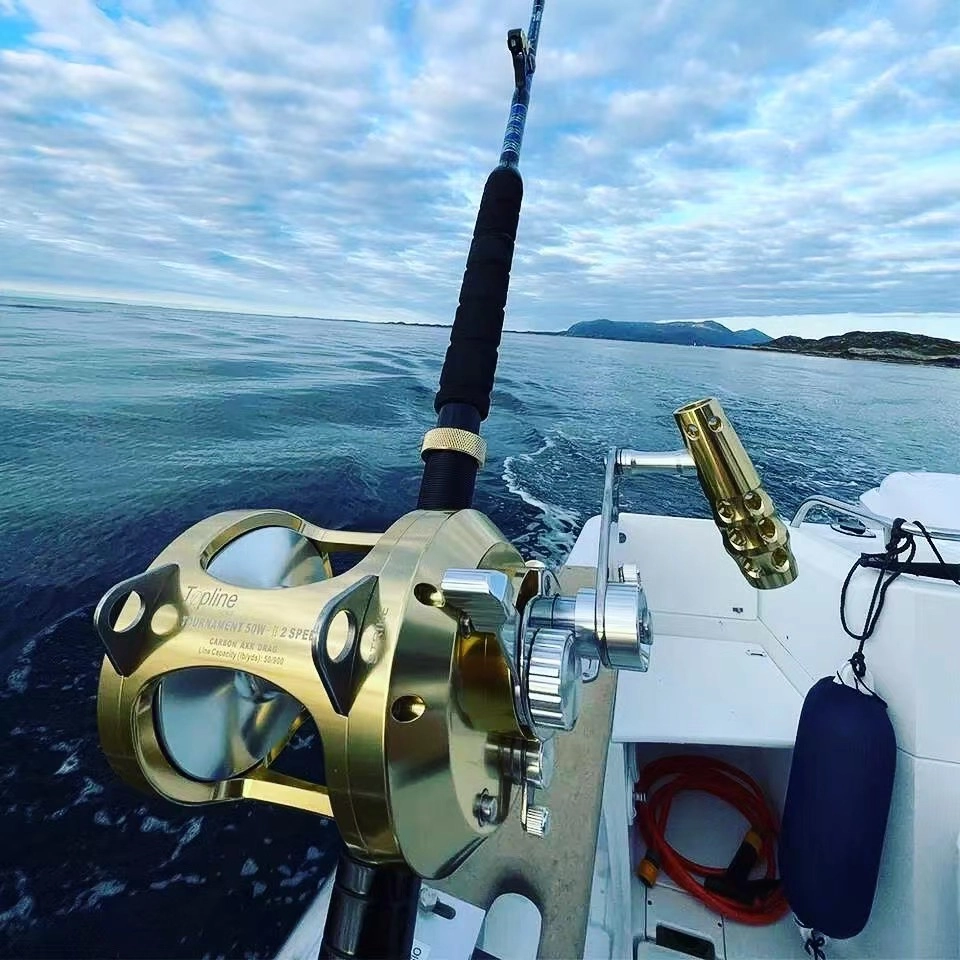Before embarking on a saltwater fishing adventure, we must ensure we have the essential components: rods, reels, lines, and lures. However, is there anything else we need to consider?
Saltwater fishing is a thrilling and rewarding activity that attracts countless fishing enthusiasts from around the world. Whether you’re a seasoned angler or a beginner looking to dive into this exciting pursuit, having the right tackle is crucial.
The vastness of the ocean and the diverse species inhabiting its depths require specific equipment to ensure a successful and enjoyable fishing experience. In this blog, we will explore the essential tackle you need for saltwater fishing and provide some valuable tips to help you get started.
How to Choose Saltwater Fishing Rods

- Choose a rod length that suits the type of fishing you’ll be doing. Longer rods provide greater casting distance, while shorter rods offer better maneuverability.
- Consider the power and action of the rod. Management refers to its strength, while action determines how the rod flexes. For saltwater fishing, medium-heavy to heavy power rods with fast or extra-fast action commonly handle larger fish and strong currents.
- Look for rods with corrosion-resistant guides and reel seats to withstand the corrosive nature of saltwater.
How to Choose Saltwater Fishing Reels

- Select a reel size based on the fishing technique and target species. Spinning reels are popular for saltwater fishing due to their versatility and ease of use.
- Look for reels with sealed or corrosion-resistant components to protect against saltwater damage.
- Consider the gear ratio of the reel. Higher gear ratios allow for faster retrieval, which is beneficial when targeting fast-swimming fish or when using certain lure types.
How to Choose Saltwater Fishing Lines

- Braided lines offer excellent strength, sensitivity, and thin diameter, allowing for increased line capacity on the reel. They also provide better resistance to abrasion and can help detect subtle bites.
- Monofilament lines are more forgiving and offer good shock absorption, making them suitable for beginners or when targeting fish that are easily spooked.
- Fluorocarbon lines are virtually invisible underwater, making them ideal for situations where fish are line-shy or in clear water conditions.
How to Choose Saltwater Fishing Lures and Baits

Saltwater fishing offers a wide range of options for lures and baits, depending on your target species. Some popular options include:
- Jigs: Versatile and effective, jigs are available in various shapes and sizes. They mimic the movement of injured baitfish and are particularly effective for predatory fish like striped bass, tuna, and snook.
- Soft Plastic Baits: Soft plastics, such as shrimp, worms, and swimbaits, are incredibly versatile and can attract a variety of saltwater species. Rig them with appropriate jig heads or weighted hooks for the best results.
- Topwater Lures: These lures create surface disturbance and imitate prey species, attracting predatory fish like redfish, tarpon, and barracuda. They offer an exciting and visually striking fishing experience.
- Live Bait: Depending on your location and regulations, live bait such as shrimp, mullet, or menhaden can be highly effective in enticing saltwater species.
How to Choose Terminal Tackle

- Hooks: Saltwater fishing requires durable and corrosion-resistant hooks. Stainless steel or nickel-plated hooks are great choices. The size of the hook will depend on the species you are targeting and the bait you plan to use.
- Sinkers: To help your bait reach the desired depth, you’ll need various sizes of sinkers. Split shot sinkers, pyramid sinkers, and bank sinkers are commonly used in saltwater fishing.
- Swivels: Swivels are essential to prevent your fishing line from twisting. Opt for high-quality, corrosion-resistant swivels to maintain the strength and integrity of your line.
Safety Equipment
Apart from fishing tackle, it’s crucial to prioritize safety on the water. Some essential safety equipment includes life jackets, a first aid kit, a whistle or air horn, sunscreen, and appropriate clothing for sun protection. Also, be sure to check the weather conditions and have a reliable means of communication, such as a VHF marine radio or a fully charged cellphone.
Several Factors of When You Go Saltwater Fishing
When it comes to saltwater fishing, the specific tackle requirements can vary based on several factors: your location, the target species you’re aiming to catch, and the fishing conditions you’ll encounter. Let’s delve into each of these factors:
Location:

a) Inshore Fishing (such as flats, estuaries, and marshes): For species like redfish, snook, or bonefish, consider using medium to medium-heavy spinning or casting rods, paired with reels designed for saltwater use. Choose lines with a pound test suitable for the targeted species and the presence of structure or vegetation.
b) Offshore Fishing: When targeting larger pelagic species like tuna or marlin, opt for heavy-duty offshore rods with a strong backbone. Match them with large capacity reels capable of holding ample line and withstand the intense fighting power of these fish. Thicker and heavier lines will be necessary to handle the demands of offshore fishing.
Target Species:
a) Bottom-Dwelling Species (such as grouper or snapper): Select heavy-action rods with strong lifting power, as these species tend to inhabit structures and put up a good fight. Pair the rods with reels featuring a durable drag system to handle the intense battles near the bottom.
b) Fast-Swimming Species (such as tuna or wahoo): Choose medium to heavy spinning or conventional rods, designed for casting or trolling, respectively. Use reels with high gear ratios to retrieve lures or bait quickly and match them with lines that have the high abrasion resistance and can withstand the speed and power of these species.
Fishing Conditions:
a) Windy Conditions: Opt for longer and heavier rods that offer better casting distance and control in windy conditions. Additionally, choose reels with sturdy construction and higher line capacity to handle strong winds and prevent line tangling.
b) Murky Water: In situations with reduced visibility, consider using lures or baits with bright colors, strong vibrations, or rattles to attract fish. Choose lines with higher visibility or opt for fluorocarbon lines that are less visible underwater.
c) Hot Summer Days: Fish may become lethargic in warmer water, so use lighter tackle with finesse presentations. This can include using lighter rods, reels, and lines to provide a more subtle and natural presentation to entice bites.
Conclusion about What Tackle Do I Need for Saltwater Fishing
Choosing the right fishing tackle is crucial for a successful and enjoyable fishing experience. By considering factors such as location, target species, and fishing conditions, you can make informed decisions about the equipment you need. Whether you’re fishing inshore or offshore, targeting bottom-dwelling or fast-swimming species, or dealing with specific conditions like wind or murky water, adapting your tackle will increase your chances of success.
Remember, fishing tackle is not a one-size-fits-all solution. It’s important to adapt your tackle to suit the unique demands of each fishing situation. By investing in high-quality rods, reels, lines, lures, and other essential equipment, as well as practicing responsible fishing techniques, you can enhance your saltwater fishing adventures and contribute to the conservation of marine ecosystems.
So, before your next saltwater fishing trip, take the time to assess the location, target species, and fishing conditions you’ll encounter. With the right tackle in hand, you’ll be well-prepared to tackle any challenges that come your way and create lasting memories while reeling in the big ones. Tight lines and happy fishing!
FAQs About What Tackle Do I Need for Saltwater Fishing
Q1: What kind of rod and reel should I use for saltwater fishing?
A1: Choose a rod and reel that suit your fishing location, target species, and fishing conditions. For inshore fishing, consider medium to medium-heavy spinning or casting rods paired with saltwater reels. Offshore fishing may require heavy-duty rods and reels designed for larger pelagic species.
Q2: How do I choose the right fishing line for saltwater fishing?
A2: Consider factors such as line strength, abrasion resistance, and visibility. Braided lines offer strength and sensitivity, while monofilament lines are more forgiving and absorb shock. Fluorocarbon lines are virtually invisible underwater. Select the appropriate pound test based on your target species and fishing conditions.
Q3: Which lures are effective for saltwater fishing?
A3:Choose lures based on the species you’re targeting and the fishing conditions. Consider the color, size, and action of the lure. Bright and vibrant colors can attract attention in murky waters, while more natural colors work well in clear waters. Match the size and swimming action of the lure to the target species.
Q4: How should I maintain and care for my saltwater fishing tackle?
A4: Rinse your rods, and reels, and tackle with fresh water after each trip to remove salt and debris. Inspect your fishing line for wear or damage and replace it if necessary. Lubricate your reel regularly with a corrosion-resistant lubricant. Store your gear in a dry and ventilated area to prevent mold and mildew.
Q5: How can I adapt my tackle to different fishing locations, species, and conditions?
A5: Tackle requirements vary depending on your location, target species, and fishing conditions. Research your fishing location to understand the unique characteristics and adjust your tackle accordingly. Consider the fighting power of the species you’re targeting and choose a tackle that can handle it. Adapt your tackle to factors like wind, water clarity, and seasonal variations.

